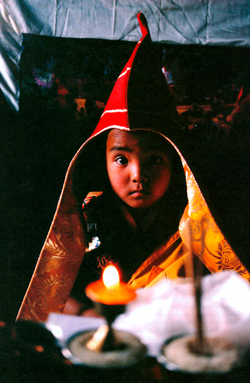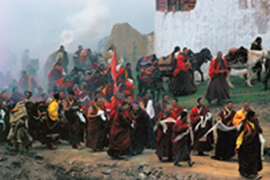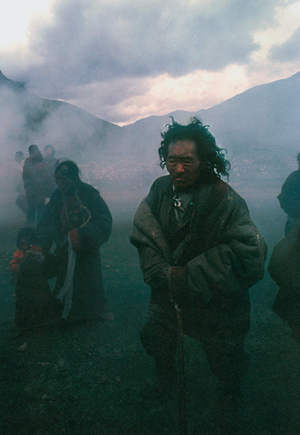Matthieu Ricard, a Tibetan Buddhist monk, scholar, and photographer, was born in France in 1946. He has lived in the Himalayas since 1972 and for the past thirty years has been carefully documenting the great masters, landscapes, and people of the region. In the words of the acclaimed French photographer Henri Cartier-Bresson, “Matthieu’s camera and his spiritual life make one, and from this springs these images, fleeting and eternal.” This past January, Tricycle contributing editor Mark Magill spoke with Ricard on the occasion of his photography exhibition at the Rubin Museum of Art in New York City.
Your images convey an enormous sense of beauty. How can beauty and its appreciation—through art, photography, and other creative activities—be of service in helping people move their lives in a positive direction? For me, photography has always been a hymn to beauty. This view was indeed reinforced and much deepened when I learned more about Buddhist philosophy and practice. According to the Buddhist teachings, Buddha-nature is present in every living being. The natural state of one’s mind, when it is not misconstrued by the power of negative thoughts, is perfection. Positive qualities such as a good heart are believed to reflect the true and basic fabric of human beings. In photography, my hope became therefore to show the beauty of human nature. Even in intense suffering there can be dignity and beauty; even in the face of destruction and persecution there can be hope. This is particularly true for Tibet and its people, who have succeeded in retaining their joy, inner strength, and confidence even while being subjected to a human and cultural genocide. For me, it is essential to inspire hope and confidence, since it is what we lack most and need most in our modern world.

How has Buddhism affected your view of art and your goals for making art? In 1967, I first traveled to Darjeeling in India and met my first spiritual teacher, Kangyur Rinpoche. After Kangyur Rinpoche died in 1975, I spent twelve years with Dilgo Khyentse Rinpoche, who was the archetype of the spiritual teacher, someone whose inner journey led him to an extraordinary depth of knowledge and enabled him to be a fountain of lovingkindness, wisdom, and compassion. I lived with him in Bhutan, India, and Nepal and accompanied him three times to Tibet. Later I traveled another ten times to Tibet. Over the years, I have taken photographs of my teachers and the world around them. My main aspiration has been to share the incredible beauty, strength, and depth of their world.
Did Dilgo Khyentse Rinpoche or your other teachers ever see or comment on your work?Since I often had a camera at hand and would also make audio recordings of most of Dilgo Khyentse Rinpoche’s teachings, he would sometimes joke, saying that if ever there would be a thangka of me, in the iconography, I would have a camera in one hand and a tape recorder in the other one. Most of the time Khyentse Rinpoche did not pay any attention at all to my photography, but occasionally he would make a grimace or tease me in some other way.
Before Khyentse Rinpoche left to return to eastern Tibet in 1985, after thirty years in exile, he told me to take a lot of film and instructed me to photograph more than ten thousand sacred images—miniatures and full-size paintings—that had survived the Chinese invasion and the subsequent destruction of the Tibetan Buddhist heritage. On another occasion, we were at the Tiger Nest cliff hermitage [Paro Takstang] in Bhutan, sitting on a balcony. He pointed to a beautiful scene and told me to take a photo. There was a line of monks garbed in red, zigzagging along the grey cliff as they climbed the narrow path. That is the only time he suggested that I take an “artistic” photograph.

To make a photograph, you point the camera and look through the lens. How do you know when to click the shutter? I may not take a photograph for months, and I feel quite bored if I have to take photographs when the conditions are not suitable. Then comes the day when people, places, and light arise in such a beautiful way that I can’t resist making an image of it with the wish to share it with others. Then I become completely involved in trying to actualize the potential of the situation. For a long time, I was a minimalist and took very few shots. As I was an expatriate Buddhist practitioner living in the East, I had limited material resources and very little film. I hardly shot fifteen or twenty rolls a year and paid great attention to each image. During the last few years, I have relaxed a bit, all the more since last year I shifted to using a high-quality digital camera. But I continue to relentlessly select only the images I like and to immediately eliminate most of the others. Presently, I mostly photograph two months a year when I travel to Tibet from Nepal.

Are there any words you would like to offer that could benefit viewers as they consider these images? An image can give us a glimpse of the impermanent and illusory nature of this world, and also show us the rich potential we have within. Beauty gives us a feeling of plentitude. According to the circumstances, this can be expressed as mere pleasure or as a deeper sense of well-being. Love and altruism are beautiful, while hatred and jealousy are unattractive. Just look at the way the former beautifies a face, while the latter disfigures it. When we see a noble being, a radiant spiritual teacher, we intuitively know that we are in the presence of great spiritual beauty. This allows us to sense that enlightenment exists and that we can reach it.
Ultimately, a yogi contemplating the ultimate nature of phenomena sees all forms as manifestations of a primordial purity, all sounds as the echoes of emptiness and all thoughts as the intertwining of wisdom. He no longer makes any distinction between the beautiful and the ugly, or the harmonious and the discordant. Beauty beyond beauty has become omnipresent. It is said that on a golden isle it is vain to search for ordinary pebbles.
Thank you for subscribing to Tricycle! As a nonprofit, we depend on readers like you to keep Buddhist teachings and practices widely available.
